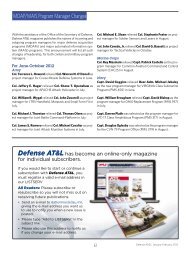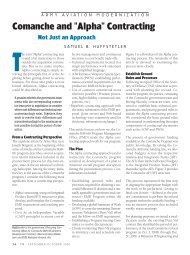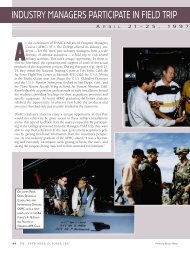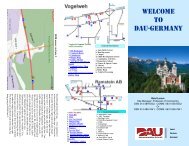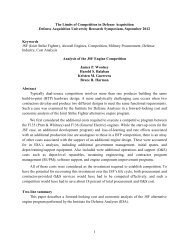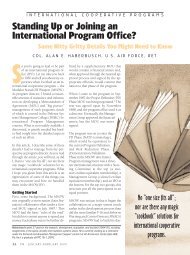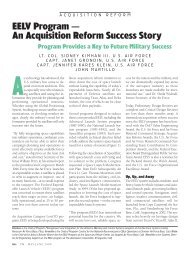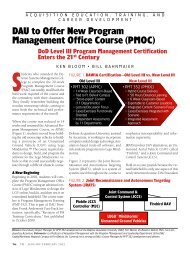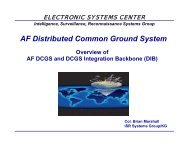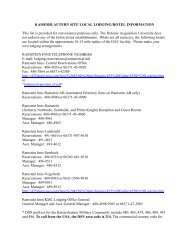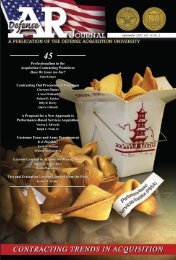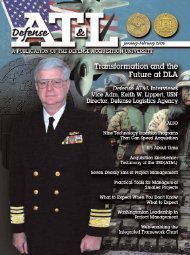Defense ARJ - Defense Acquisition University
Defense ARJ - Defense Acquisition University
Defense ARJ - Defense Acquisition University
You also want an ePaper? Increase the reach of your titles
YUMPU automatically turns print PDFs into web optimized ePapers that Google loves.
<strong>Defense</strong> <strong>Acquisition</strong> Review Journal<br />
SoSE experts envision future requirements generation as a fluid process, capable<br />
of coping with shifting environments. Accordingly, SoS requirements must provide<br />
for flexibility in parameters and boundaries. Because overall SoS performance results<br />
from complex component system interactions, the J-8’s ability to produce an “integrated,<br />
time-phased, fiscally informed capability, acquisition, and divestiture plan”<br />
(DAPA Report, 2006, p. 39) that captures SoS capabilities is questionable. Instead,<br />
the J-8 should describe SoS requirements more holistically. The proposed JCAD system<br />
could accommodate such an approach by emphasizing overarching capabilities<br />
and architectures, rather than traditional program proposal elements such as system<br />
technical descriptions, delivery profiles, and production quantities.<br />
Furthermore, the JCAD process pits Services against one another to compete<br />
for material solutions. This competition would hinder development and integration<br />
of SoS components across Service boundaries. As the JCAD process is currently<br />
envisioned, Services competing to develop SoS components would lack incentives to<br />
prioritize capabilities that enhanced other Services’ needs. SoS development in this<br />
parochial manner would quickly degenerate into inefficient parallel engineering of<br />
systems that might form a loosely interoperable system, but would remain a far cry<br />
from the capabilities that integrated SoSE could achieve.<br />
Several modifications to the proposed JCAD could tailor its processes to better<br />
support SoS requirements generation. First, because SoS development must be<br />
flexible and iterative, the J-8 should describe the incremental value desired for new<br />
SoS (or particular component) capabilities rather than attempt to create an integrated,<br />
time-phased capability plan prior to program inception. Second, material solutions<br />
proposals for SoS components should broadly describe capabilities and integrating<br />
architectures instead of specific technical descriptions and force structure proposals.<br />
Finally, inter-Service competition should be based on selecting the best leader for<br />
SoS integration efforts. This approach would facilitate joint cooperation on proposals,<br />
establishing a more collaborative atmosphere for SoS development.<br />
conclusion—recoMMenDations to tailor reforM<br />
Decades of unsuccessful reforms have frustrated generations of professionals<br />
seeking to fix defense acquisition through incremental improvements. The DAPA<br />
panel proposes to break this pattern with a sweeping reform plan, actionable recommendations,<br />
and an implementation strategy. While these proposals offer significant<br />
promise, they do not anticipate critical challenges presented by SoS development.<br />
While defense leadership is counting on SoS capabilities, the current and proposed<br />
acquisition systems are ill equipped to facilitate actual development of these<br />
systems. To better facilitate SoS acquisition, the following modifications to the DAPA<br />
Report recommendations are suggested:<br />
�<br />
Organization. Plans to restructure defense acquisition must incorporate mechanisms<br />
to coordinate joint efforts. Assignment of a lead-sponsor to oversee inter-<br />
Service collaboration in SoS development would support this goal.<br />
188



